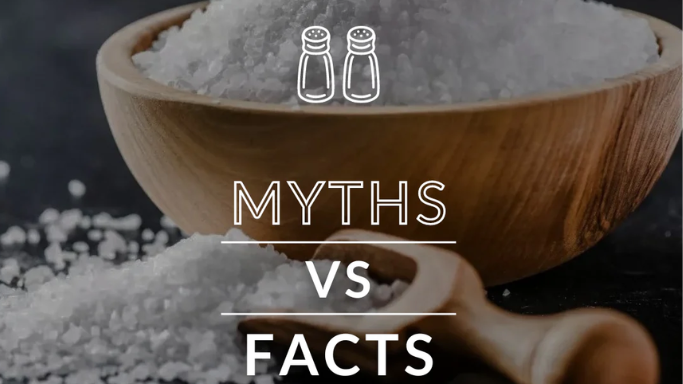Salt is essential for human health, playing a crucial role in hydration, nerve function, and maintaining fluid balance. However, over the years, various myths have cropped up around salt, leading to confusion about its health effects. In this post, we’ll explore common salt myths and separate them from the facts.
Myth 1: Salt is Bad for Everyone
Fact: Not all salt is bad. While it’s true that excessive salt intake can lead to health problems such as high blood pressure, not everyone needs to cut it out of their diet completely. For most people, the key is moderation. Salt is essential for bodily functions like fluid balance, nerve transmission, and muscle function.
Who Needs to Worry: People with conditions like hypertension or those at risk of heart disease may need to be more cautious about salt intake. For healthy individuals, moderate amounts of salt, especially from natural sources like sea salt or Himalayan pink salt, are generally not harmful.
Myth 2: Sea Salt is Healthier than Table Salt
Fact: Both sea salt and table salt are chemically similar; they are primarily made up of sodium chloride. The main difference lies in how they’re processed. Sea salt is harvested through evaporation of seawater, which may leave trace minerals behind, but these minerals are present in such small amounts that they don’t significantly affect the health benefits of the salt.
What Matters More: The main consideration when choosing salt is the amount of sodium you consume, not whether it’s from the sea or the earth. While sea salt may have a different texture and flavor, it doesn’t offer substantial health benefits over regular table salt.
Myth 3: Salt Causes High Blood Pressure in Everyone
Fact: While excessive salt intake is a well-established risk factor for hypertension (high blood pressure) in many individuals, it doesn’t affect everyone the same way. Some people are considered salt-sensitive, meaning their blood pressure increases significantly when they consume more salt. Others, however, are salt-resistant, meaning they can consume higher levels of salt without significantly affecting their blood pressure.
Genetic Factors Matter: A person’s sensitivity to salt depends largely on genetic and environmental factors. This is why some people can tolerate more salt than others. It’s important for individuals with hypertension or a family history of heart disease to monitor their sodium intake and consult with a healthcare provider.
Myth 4: Cutting Out Salt Will Lead to Healthier Outcomes
Fact: Completely eliminating salt from your diet is not advisable. Salt plays an essential role in regulating fluid balance, nerve function, and muscle contraction. While reducing excessive sodium intake can benefit people at risk for high blood pressure, completely eliminating salt can lead to negative side effects such as hyponatremia (low sodium levels), which can cause nausea, headaches, and muscle cramps.
Moderation is Key: For most people, the key is consuming the right amount of salt. According to the World Health Organization (WHO), the recommended daily salt intake for adults is less than 5 grams (about one teaspoon), but individual needs may vary.
Myth 5: All Salts are the Same
Fact: While all salts are made primarily of sodium chloride, the texture, flavor, and mineral content can vary significantly between different types. Table salt is heavily processed and often contains additives like anti-caking agents. On the other hand, sea salt and Himalayan pink salt are typically less processed and may contain trace minerals such as calcium, magnesium, and potassium.
Mineral Content Doesn’t Change Much: While these minerals may slightly alter the flavor or texture, they don’t significantly affect the health benefits of the salt. The primary concern with salt consumption should be the sodium content, not the trace minerals.
Myth 6: Himalayan Pink Salt is Much Healthier than Regular Salt
Fact: Himalayan pink salt has become popular due to its striking color and purported health benefits, with some claiming it contains over 80 minerals and can help detoxify the body. While it does contain trace minerals like iron, calcium, and magnesium, these minerals are present in such small amounts that they have little to no effect on your health.
What You Need to Know: Himalayan pink salt is a better alternative for people who enjoy the flavor and texture, but from a nutritional standpoint, it doesn’t offer significant health benefits over regular salt. Like all salts, it’s important to use it in moderation.
Myth 7: Salt Is the Main Contributor to High Blood Pressure
Fact: Salt is just one factor that can contribute to high blood pressure. Other factors such as diet, physical activity, genetics, and stress levels can all play significant roles in your overall blood pressure levels. While reducing sodium intake can help, focusing solely on salt won’t necessarily solve blood pressure issues.
The Bigger Picture: To manage high blood pressure, it’s important to consider your overall diet, which should be rich in fruits, vegetables, and whole grains, as well as getting regular physical activity and managing stress.
Myth 8: Salt Is Only Used for Flavoring Food
Fact: While salt is often used for flavoring, its role in cooking and food preservation is much broader. Salt helps to preserve food by inhibiting the growth of bacteria and mold, which is why it’s used in canning, pickling, and curing meats. Salt also has a unique ability to enhance other flavors, making foods taste more vibrant.
Beyond Flavor: Salt is also used in baking, where it helps balance the sweetness of baked goods, control yeast fermentation, and stabilize the structure of dough.
Conclusion
Salt has been the subject of much debate, but understanding the facts vs. myths can help you make more informed decisions about its role in your diet. While it’s important to monitor your salt intake to avoid excessive consumption, salt itself is not inherently bad when consumed in moderation. The key to a healthy relationship with salt is understanding your individual needs and using it wisely to enhance flavor, texture, and the preservation of your food.




